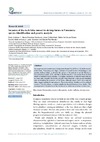Identificador persistente para citar o vincular este elemento:
https://accedacris.ulpgc.es/jspui/handle/10553/60021
| Campo DC | Valor | idioma |
|---|---|---|
| dc.contributor.author | Lodeiros, César | en_US |
| dc.contributor.author | González Henríquez, María Nieves | en_US |
| dc.contributor.author | Cuéllar-Anjel, Jorge | en_US |
| dc.contributor.author | Hernández-Reyes, Dailos | en_US |
| dc.contributor.author | Medina-Alcaraz, Carolina | en_US |
| dc.contributor.author | Quinteiro, Javier | en_US |
| dc.contributor.author | Rey-Méndez, Manuel | en_US |
| dc.date.accessioned | 2020-01-08T10:51:23Z | - |
| dc.date.available | 2020-01-08T10:51:23Z | - |
| dc.date.issued | 2019 | en_US |
| dc.identifier.issn | 2242-1300 | en_US |
| dc.identifier.other | Scopus | - |
| dc.identifier.uri | https://accedacris.ulpgc.es/handle/10553/60021 | - |
| dc.description.abstract | An inspection was carried out at shrimp farms located South West of Lake Maracaibo (Zulia State, Venezuela), with high incidences of mussel bivalve. Morphological and genetic analysis helped to identify the species as the dark false mussel Mytilopsis leucophaeata Conrad, 1831, and this is the first record of the species from tropical waters of northern South America. The highest incidences of mussels were detected in ponds and channels but no live mussels were observed in the coastal intertidal area surrounding the entrances of the farms, although empty shells were detected there, suggesting their former presence. The environmental conditions of the artificial system of shrimp culture, is a niche suitable for the proliferation of the bivalve. The consequences of the presence of this bivalve in the production of shrimp are discussed. | en_US |
| dc.language | eng | en_US |
| dc.relation.ispartof | BioInvasions Records | en_US |
| dc.source | BioInvasions Records [ISSN 2242-1300],v. 8(4), p. 838-847 | en_US |
| dc.subject | 251092 Acuicultura marina | en_US |
| dc.subject.other | Dreissenidae | en_US |
| dc.subject.other | Invasive alien species | en_US |
| dc.subject.other | Bivalve mollusks | en_US |
| dc.subject.other | Shrimp culture | en_US |
| dc.title | Invasion of the dark false mussel in shrimp farms in Venezuela: Species identification and genetic analysis | en_US |
| dc.type | info:eu-repo/semantics/Article | en_US |
| dc.type | Article | en_US |
| dc.identifier.doi | 10.3391/bir.2019.8.4.12 | en_US |
| dc.identifier.scopus | 85076745031 | - |
| dc.identifier.isi | 000498658800012 | - |
| dc.contributor.authorscopusid | 7004195633 | - |
| dc.contributor.authorscopusid | 35792228700 | - |
| dc.contributor.authorscopusid | 55377361000 | - |
| dc.contributor.authorscopusid | 57212461922 | - |
| dc.contributor.authorscopusid | 57212461054 | - |
| dc.contributor.authorscopusid | 6602211761 | - |
| dc.contributor.authorscopusid | 10243544500 | - |
| dc.description.lastpage | 847 | en_US |
| dc.description.firstpage | 838 | en_US |
| dc.relation.volume | 8 | en_US |
| dc.investigacion | Ciencias | en_US |
| dc.type2 | Artículo | en_US |
| dc.contributor.daisngid | 31990525 | - |
| dc.contributor.daisngid | 31992685 | - |
| dc.contributor.daisngid | 12638660 | - |
| dc.contributor.daisngid | 32017944 | - |
| dc.contributor.daisngid | 32023142 | - |
| dc.contributor.daisngid | 1566180 | - |
| dc.contributor.daisngid | 4351105 | - |
| dc.contributor.wosstandard | WOS:Lodeirosi, C | - |
| dc.contributor.wosstandard | WOS:Gonzalez-Henriquez, N | - |
| dc.contributor.wosstandard | WOS:Cuellar-Anjel, J | - |
| dc.contributor.wosstandard | WOS:Hernandez-Reyes, D | - |
| dc.contributor.wosstandard | WOS:Medina-Alcaraz, C | - |
| dc.contributor.wosstandard | WOS:Quinteiro, J | - |
| dc.contributor.wosstandard | WOS:Rey-Mendez, M | - |
| dc.date.coverdate | Noviembre 2019 | en_US |
| dc.identifier.ulpgc | Sí | es |
| dc.description.sjr | 0,485 | |
| dc.description.jcr | 1,504 | |
| dc.description.sjrq | Q2 | |
| dc.description.jcrq | Q3 | |
| dc.description.scie | SCIE | |
| item.fulltext | Con texto completo | - |
| item.grantfulltext | open | - |
| crisitem.author.dept | GIR IUNAT: Biología Integrativa y Recursos Biológicos | - |
| crisitem.author.dept | IU de Estudios Ambientales y Recursos Naturales | - |
| crisitem.author.orcid | 0000-0003-1110-0448 | - |
| crisitem.author.parentorg | IU de Estudios Ambientales y Recursos Naturales | - |
| crisitem.author.fullName | González Henríquez, Maria Nieves Elvira | - |
| Colección: | Artículos | |
Citas SCOPUSTM
14
actualizado el 08-jun-2025
Citas de WEB OF SCIENCETM
Citations
13
actualizado el 18-ene-2026
Visitas 5
421
actualizado el 16-ene-2026
Descargas
298
actualizado el 16-ene-2026
Google ScholarTM
Verifica
Altmetric
Comparte
Exporta metadatos
Los elementos en ULPGC accedaCRIS están protegidos por derechos de autor con todos los derechos reservados, a menos que se indique lo contrario.
